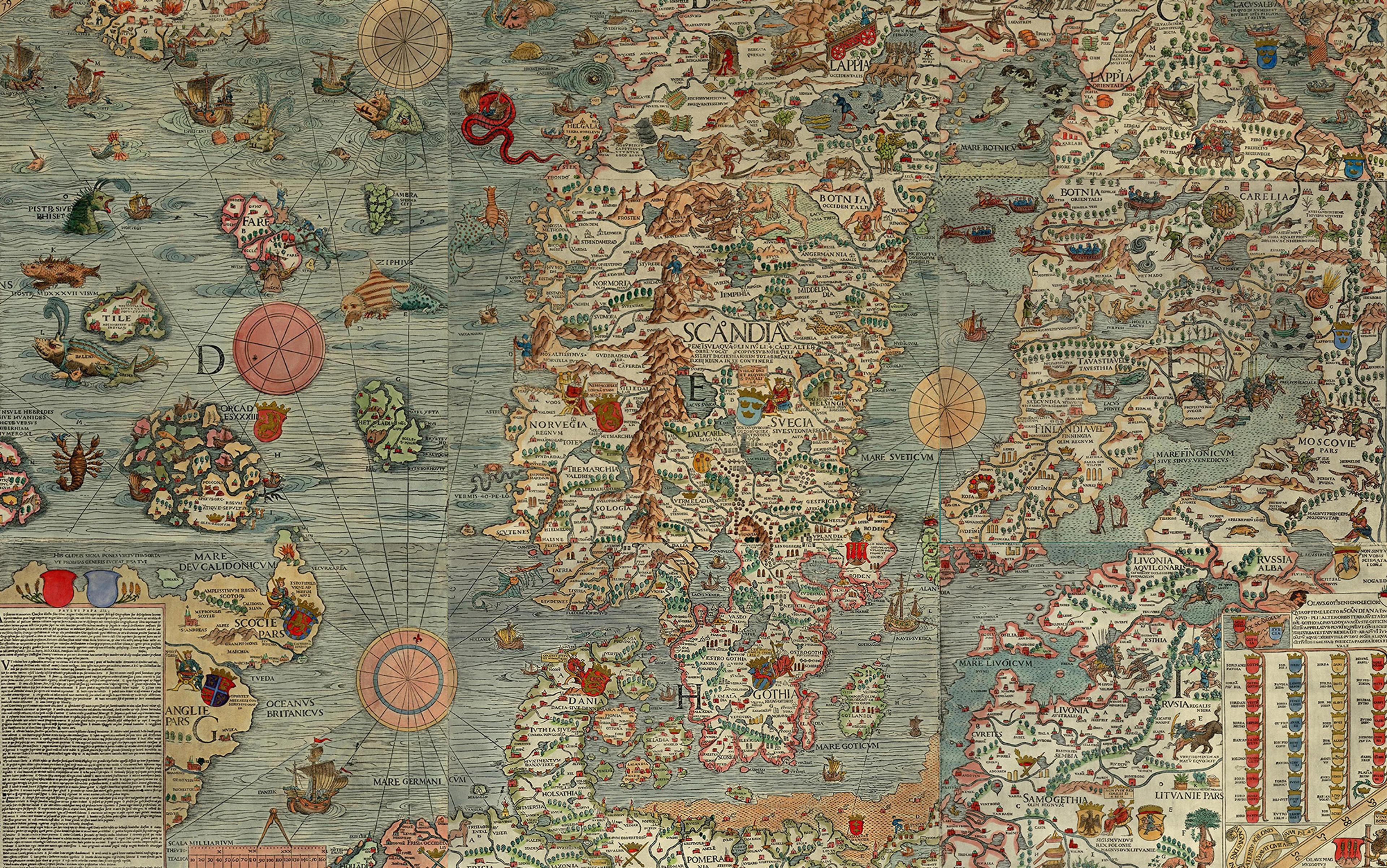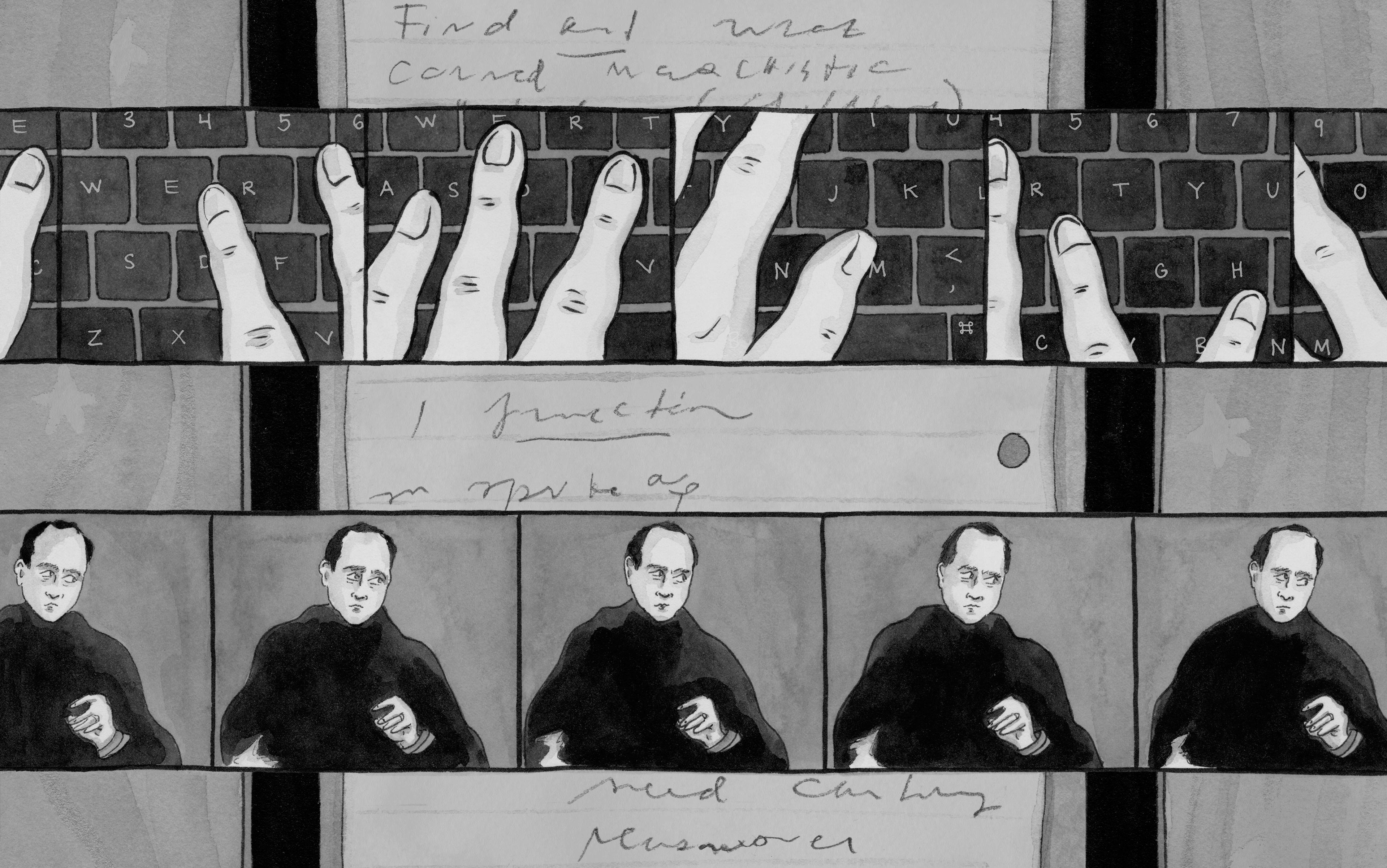There it floated, a luminous orange doughnut, glowing and fuzzy-edged, against a sea of darkness (Figure 1, below). Had it arrived without headline or caption, the world’s first ever image of a black hole might not have been recognised. Relayed across global news media, in April 2019, with appropriate fanfare and explanation, it caused the kind of stir you might expect of a scientific breakthrough. Prior to this, black holes had been ‘seen’ with the eye only through the images of science fiction. But now that we had a visual fix on black holes, an entity known only through abstract theory and via its gravitational effects on other bodies, were we any the wiser about them?
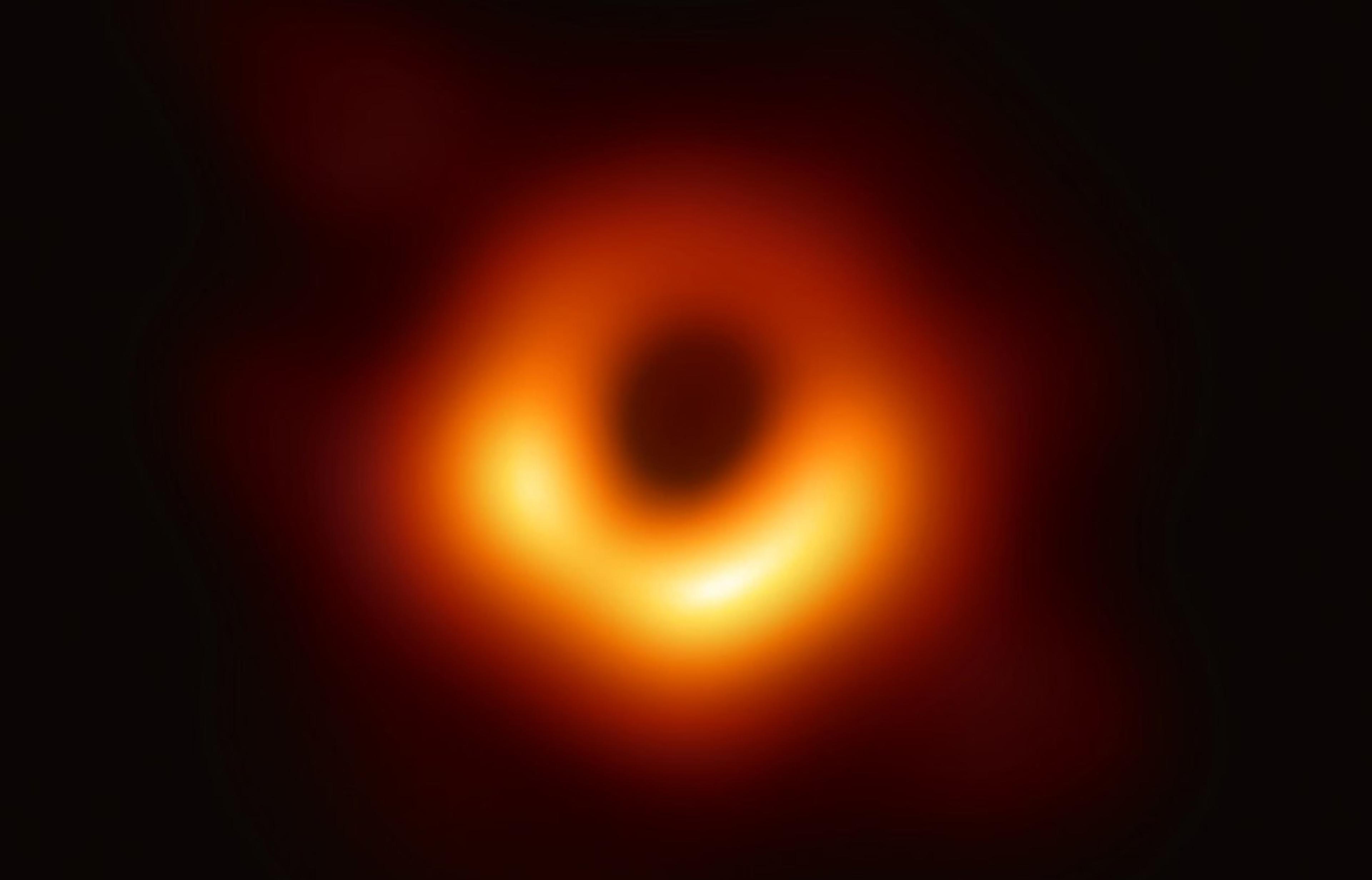
The supermassive black hole at the centre of the Messier 87 galaxy, captured by the Event Horizon Telescope. Photo courtesy EHT collaboration
The image of M87* (the supermassive black hole at the centre of galaxy Messier 87) is the remarkable result of the efforts of researchers working with the international Event Horizon Telescope. At first sight so novel and game-changing, this unprecedented image is not the ‘photograph’ it appears to be. Instead it’s part of a long tradition of diagrammatically representing the heavens that stretches back at least as far as Galileo’s time-lapse sketches of sun spots, observed through a telescope at the turn of the 17th century. Galileo also made drawings of the Moon’s ridges and valleys, extrapolating imaginatively – from shifting light and dark patterns across the Moon’s phases – to surmise its physical features.
Perhaps more surprisingly, the black hole image has a lot in common with much earlier images of another sort of deep space, containing a different hidden entity: the sea monster. The Carta marina et descriptio septentrionalium terrarum (‘Marine Chart and Description of the Northern Lands’) was drawn in 1539 in Venice by Olaus Magnus, the Swedish geographer and titular archbishop of Uppsala, who was exiled in Rome during the early decades of the Reformation (main image, above, and Figure 3, below). With its array of octopuses, whales, walruses and other marine life in the North Atlantic, the chart is seemingly a world apart from the iconic image of M87*. Yet both are composite images derived from multiple sources, only some of which were visual. These sources were analysed in the mind and (via computers or mathematical instruments) compared with existing knowledge; the summary conclusions drawn from these mental excursions were then converted into visual images. These selective, compound, confected images – diagrams, in other words – enable us to ‘see’ in ways that are impossible in real life.
During the 15th and 16th centuries, when oceans were the spaces between worlds, marine animals, often so prodigious that they were termed sea monsters, were difficult to see and even harder to analyse, their very existence uncertain. Broadly construed, the history of space science is also a story of looking across and into the ocean – that first great expanse of space rendered almost unknowable by an alien environment. Deep space, like the deep sea, is almost inaccessible, with the metaphorical depth of space echoing the literal depth of oceans. These cognitive and psychic parallels also have an analogue in the practicalities of survival, and training for space missions routinely includes stints under water.
How can we grasp nature’s image and put it on a page? How do we judge the truthiness of images of nature? These questions are particularly challenging when it comes to images of the far reaches of galactic and oceanic space, which share a quality that we might call sensory distance. Such places exist at great remove: too small to discern with bodily senses (mere microns across, perhaps), too physically distant for instruments (outer space and ocean depths), or too inhospitable for sustained human presence. Visualising places of sensory distance requires distinctive approaches, not merely to collect information but also to interpret it, since the information gathered is patchy. In the absence of comprehensive and accessible information, acquiring knowledge about sea monsters and black holes calls for imaginative image-making.
Premodern chroniclers and naturalists had long attempted to describe, illustrate and classify distant wonders, from gold-digging ants to the Fountain of Youth. Such rare and unexpected marvels appeared to bend the rules of nature, and whether they were actual lifeforms, or phenomena assembled from piecemeal observations – such as the seemingly monstrous peoples at the edges of the Earth, or barnacle geese said to grow on trees – they were characterised by being difficult to observe in the field. Mariners had some direct, if limited, opportunities to witness deep-sea life. They might catch glimpses of whales surfacing for air from a whaling ship, or garner direct access to the bodies of whales and live to tell the tale. Landlubbers, however, were far removed from sea monsters in the flesh. If they lived near the sea, they might encounter extraordinary animals in fishermen’s catches, dashing to the beach if they got wind of a beached whale, or gazing at half-decayed specimens washed up on shore – drift whale.
A scene in a natural history compendium manuscript devoted primarily to marine life reveals people from many walks of life, some with animals in tow, gathering to gawk at the butchering of a whale beached near Antwerp in 1577 (Figure 2, below). This whale appears to still be alive: dark spray shoots out of its blowhole, its open eye gazes back at us. Fishermen had to work quickly to butcher such animals, before their flesh or precious oil spoiled. Scenes of whale dissections often show barrels nearby for collecting this liquid gold.
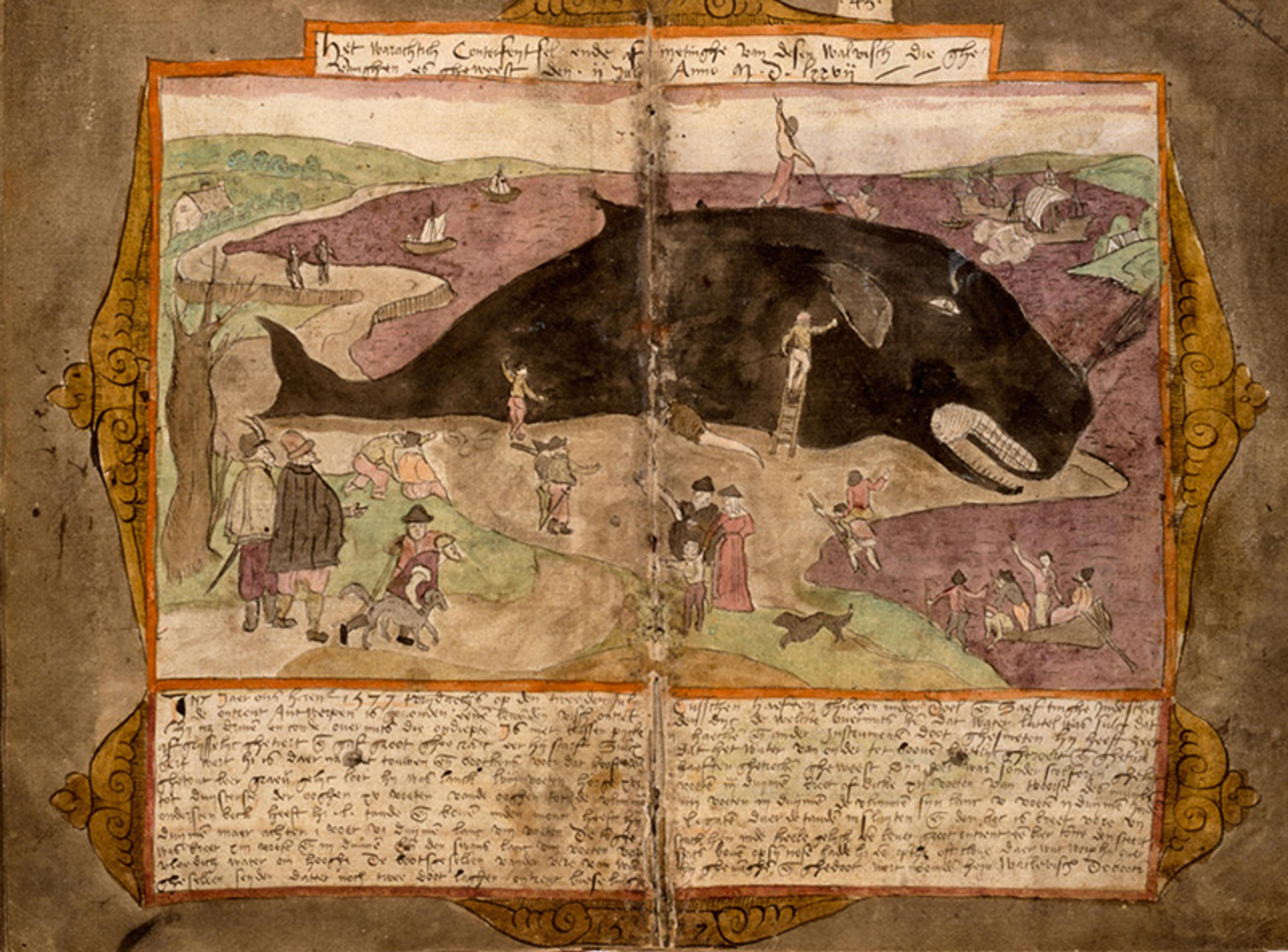
Watercolour illustration from the Visboeck (1577-80) of Adriaen Coenen. Courtesy the National Library of the Netherlands
Viewers without access to a beached corpse had to make do with their imaginations and the testimonials of others, in the form of printed images and descriptions in broadsheets, travel accounts and natural history compendia. Many images of animals on Olaus’s map were reused in his Historia de gentibus septentrionalibus, or ‘Description of the Northern Peoples’, drawn in Rome in 1555. Indeed, his map and book became the basis for fishy beings depicted in many later maps and influential natural history treatises across Europe for years to come, including Sebastian Münster’s Monstra marina et terrestria (Basel, 1544), Conrad Gessner’s four-volume Historiae animalium (Zürich, 1551-8), Abraham Ortelius’s map of Iceland in his Theatrum orbis terrarum (Antwerp, 1590), even Edmund Spenser’s The Faerie Queene (London, 1590-6). If they were lucky enough to enjoy the right connections, viewers might also visit a cabinet of curiosities, and there encounter whalebones alongside everything from ancient cameos of Neptune to stuffed blowfish. For example, in the cabinet assembled in the 17th century by Ole Worm, a University of Copenhagen scholar of Greek, Latin and archaeology, visitors could view a narwhal horn with narwhal skull attached.
Sea unicorns rise above the waves; various coiled, spiked, tentacled and spouting specimens are locked in battle
Many of the written sources available to Olaus came from classical antiquity, historical chronicles and travel accounts. He might have seen images in bestiaries (moralising, often-illuminated accounts of animals), or gazed, in an illustrated Bible, upon Leviathan (who swallowed Jonah). Historia naturalis (c77-9 CE) by Pliny the Elder, a source that Olaus consulted frequently, noted that many marine animals were enormous: whales (balaenae), lobsters (locustae) and eels (anguillae). Pliny writes of whirlpools and killer whales (orcas) that were known for attacking other whales and their calves. Turning such verbal descriptions into images was challenging: how could a whale’s spout be drawn from Pliny’s description of animals with mouths on the top of their heads?
The top-left quarter of Olaus’s map (Figure 3, below) documents an array of distinctive sea animals. A giant lobster grips a person in its left pincer; sea unicorns or horned creatures – inspired, perhaps, by mariners’ descriptions of narwhals or swordfish – rise above the waves; and various coiled, spiked, tusked, tentacled and spouting specimens are locked in battle, with one another or with hapless ships. The style of the woodcut images is so different from colour illustrations in National Geographic or Nature that, to 21st-century viewers more used to the look of photographs, it’s easy to dismiss them as whimsy, not science. Yet such scenes are the Renaissance equivalent of nature documentaries. Take a cetacean fight-scene vignette revealing a killer whale attacking a baleen whale with a suckling calf: the exposed spine of the baleen whale suggests that the artist had seen either a beached whale or come across news about one in a broadsheet, where such carcasses might be illustrated. The style of these images results from the interplay between the medium of the woodcut, and the artist’s attempt to convey the drama of the scene, just as the M87* image is a consequence of the intersection of phenomenon and technology.
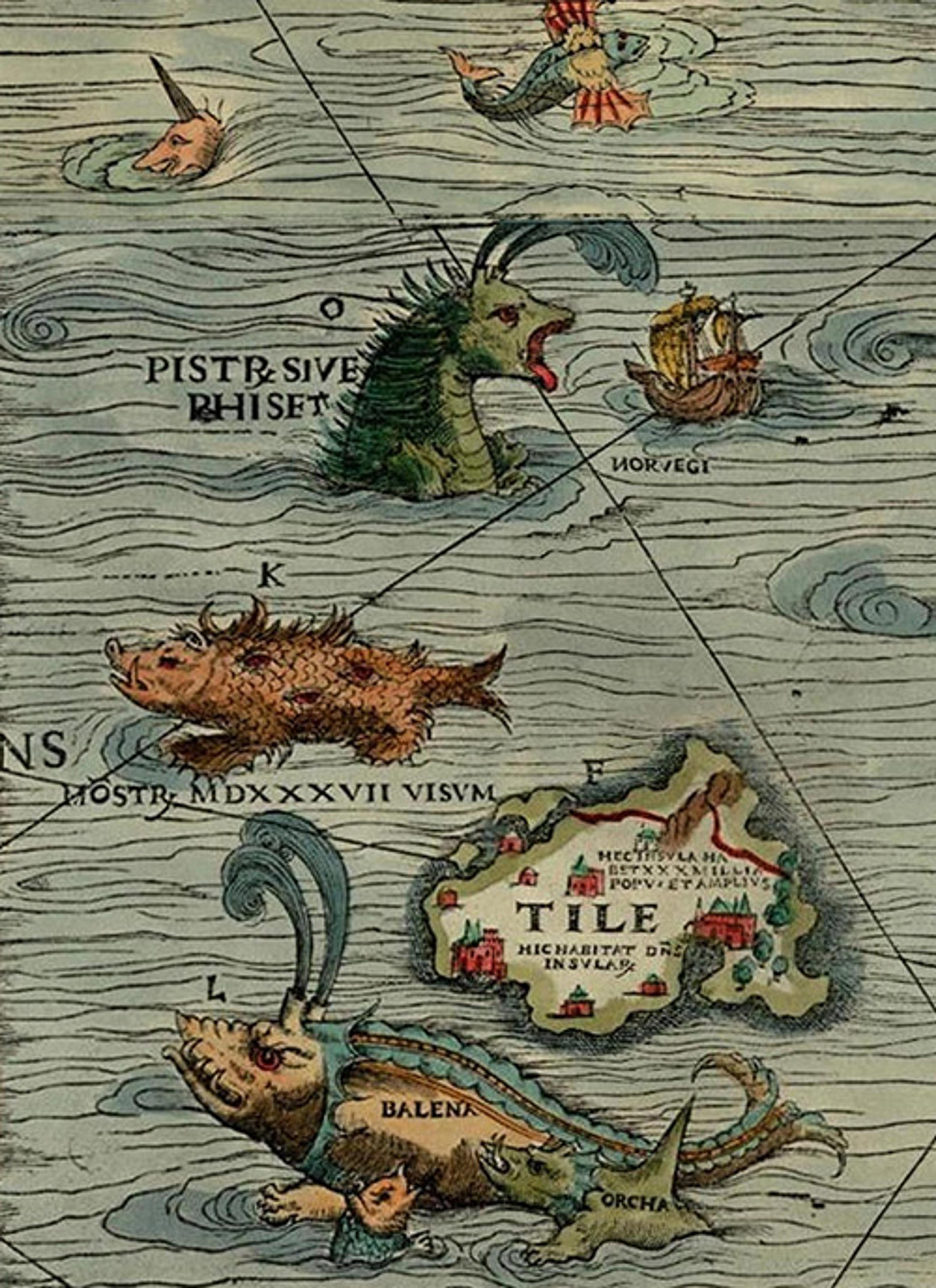
Detail from the Carta marina (1539) by Olaus Magnus
Ancient climatological theories held that extremes of latitude generated monsters – category-breaking creatures, deformed by the climate into fundamentally different beings from those found at more temperate latitudes. It was thus perfectly reasonable to expect unusual animals in the far north. Olaus, as a Swede in Rome, would have been aware that southern European climes were considered ideal by the ancients, whereas the northern latitudes of Sweden were deemed to encourage savagery, not civility. Just as today’s astrobiologists try to predict imaginatively the shape of life in distant galaxies with hostile gravitational and atmospheric conditions, so did scholars during the Renaissance.
Adriaen Coenen was born in the fishing port of Scheveningen in Holland around 1514. A fisherman’s son, Coenen regularly saw and heard of strange and familiar denizens of the deep being landed on beaches, sold in markets and exhibited at fairs. He handled marine animals as a fish auctioneer in Scheveningen, and later as master of wrecks for the province of Holland – a post that gave him access to all manner of beached animals. He even assembled a dried fish collection that he showed to paying visitors at fairs. In 1577, aged 63, Coenen began compiling his Visboeck or Visboek (‘Fish Book’). This was a visually lavish miscellany or commonplace book, comprising more than 400 leaves (some 850 pages) of notes and watercolours about marine life (and a few terrestrial lifeforms, from camels to basilisks), his untrained but meticulous hand bringing animals to life in action poses: spouting whales; cephalopods with tentacles outstretched; porcupines shooting quills. Typically, he rendered aquatic specimens against a blue or purple wash to evoke animals in their element.
Coenen’s lifetime of pescatarian experience, which included inspecting the insides of beached whales, was on view for anyone who perused his fish books. Yet he also consulted works owned by a rich neighbour – including those of Olaus and natural histories by Pierre Belon, Conrad Gessner and Guillaume Rondelet – and conversed with physicians and naturalists at the nearby Leiden University, founded in 1575. His miscellanies demonstrate the way that visual images and knowledge of deep-sea life were fashioned in parallel, and enriched over time by a community of scholars, artists, technician-artisans and eyewitnesses, just as they are today for deep space.
The kind of collaborative practices that went into producing visual images were themselves legion (Figure 4, below). It took an array of people to make a printed, illustrated woodblock map in the 16th century. The Flemish engraver Johannes Stradanus depicted the inky steps involved, from design to printed book, in his own compendium of discoveries. Typically, the publishers brought scholars and artisans together, oversaw the work, and paid for the equipment and print run. They relied on a network of correspondents to send new information – sketches or maps – as it became available. A cartographer would draw the new map by hand, often consulting earlier maps, geographies and travel accounts for topographical information. A designer assembled the other visuals, such as illustrations; a poet or scholar would write verses or text; an engraver cut the woodblocks. Sometimes a single individual fulfilled several roles. For coloured examples, an illuminator would painstakingly paint each printed map by hand, sometimes on commission once a copy was sold.
The image doesn’t show radiation from the black hole but its absence – its shadow or silhouette
Although today’s black hole image emerges out of different material technologies, it, too, relies on techniques of imaginative prototyping of distant objects – about which only limited evidence can be gathered, by circuitous means – and collaborative practices of visualising.
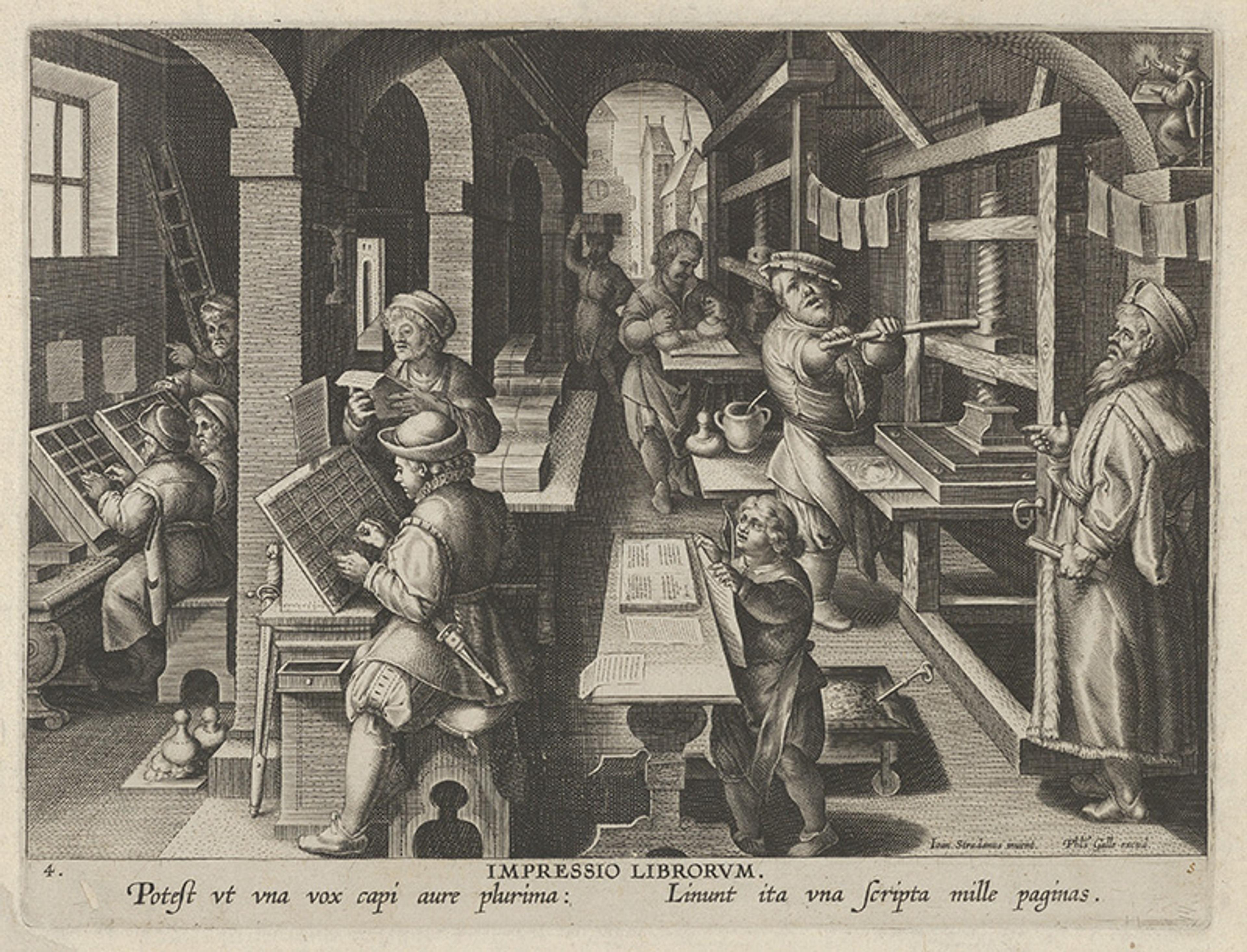
From New Inventions of Modern Times: The Invention of Book Printing (c1600) by Jan Collaert. Courtesy the Met Museum, New York
Black holes are dark because no light can escape them: their enormous mass exerts a gravitational pull so strong it bends light waves back into the black holes themselves, rendering them invisible. Once you get too close to a black hole – once you pass its event horizon – there’s no escaping its gravitational pull. ‘Seeing’ a black hole – in the strict sense of receiving electromagnetic waves in the frequency range of visible light – is therefore impossible. What, then, are we looking at when we gaze at the image of M87*? Nothing in nature, since the ‘visual’ evidence is indirect. The image doesn’t show radiation from the black hole but its absence – its shadow or silhouette: the swirling hot gases in orbit, falling inexorably towards the event horizon, or point of no return.
‘Seeing’ these gases took a village: a series of eight ground-based radio (radio!) telescopes that, together, mimicked a virtual, mega-telescope the size of our own Earth. The telescopes received electromagnetic radiation in the 1.3 mm wavelength range, far longer than the wavelengths of visible light. The final image that we see with our eyes was devised by dozens of experts from an international team of astronomers. They carefully processed trillions of bits of data and converted it from waves beyond the visible light spectrum into the field of the visible. The images of M87*, like the marine animals on Olaus’s map, are in that sense diagrams: scientific objects, images made by intentionally distilling material from a larger body of empirical information and theoretical rubrics in order to bring certain features into focus and to make or show knowledge in visual form.
The diagram is a slippery category, one we cannot apprehend through our emotions. Put another way, we can’t identify or read a diagram from another era or culture simply by looking at it and asking our gut whether it looks ‘scientific’. Diagrams are devised by interpretative communities made up of readers, makers and practitioners. Each interpretative community has its own distinct pictorial language. Only by analysing the image in the light of scientific knowledge, practices and assumptions of its own age – a technique that the British art historian Michael Baxandall called ‘the period eye’ – can we figure out whether or not it was intended to convey information, where the boundaries between information, aesthetics and the limits of the medium or technology (such as the wood of woodblocks) lay, and how the diagram operated.
Natural objects exist in the world independently of our knowledge of them and – what is key here – independently of any particular community’s knowledge of them. In other words, ‘new’ animal species might not be at all new to local communities, while local oral testimonies might contain descriptions of animals that don’t conform to any ‘known’ creatures. We can see this in action in how species discoveries are authenticated today.
In 2016, scientists identified a new, 24-foot-long whale species in the north Pacific Ocean. Of course, accounts of this whale had been circulating among fishermen for decades. But the language of ‘scientific discovery’ sidesteps such non-elite knowledge until it has been verified by experts, which verification usually marks the official date of discovery. Species don’t come into being when they’re published in a scientific journal. But publication is when they come into being as a scientific object.
Historians of science are likewise aware that animal species ‘discovered’ by travellers from Europe in the course of transoceanic travel weren’t new to the peoples already living in those regions. Inuit had hunted narwhals for millennia, for example, before Europeans knew much about them beyond their (unicorn) horns. Scattered accounts of New World animals also reached naturalists in Europe long before members of their particular community of experts had handled, documented or collected them. Seemingly opaque illustrations on Renaissance maps were, in fact, attempts to extrapolate from sailors’ accounts of real animals. Renaissance mariners’ testimonies about the things they glimpsed in the open ocean weren’t directly visible to naturalists who had no nautical experience – but ‘unknown’ animals did exist, and these naturalists would eventually corroborate them.
A black hole is an invisible object as wondrous and monstrous as a being in a medieval bestiary
In short, imagination was essential to making and representing visual knowledge about sea monsters. These creatures couldn’t be easily seen in nature. Complete specimens were rare. No individual artist or woodblock cutter was likely to have seen the aquarium of beasties on Olaus’s map, and certainly not all of them alive. This made classification and identification difficult. The 13th-century German scholar Albertus Magnus suggested that walruses were a kind of whale. But what exactly were the defining characteristics of a whale, anyway? The marine unicorn, or narwhal, was an animal known first through its horn, a durable body part more likely to wash up on shore and survive the ravages of waves and seaside air than the beast’s fleshy body. Illustrators might be acquainted with mariners’ tales, they might get the chance to examine partial evidence, such as horns, or see marine animal carcasses washed ashore. In their imaginative reconstructions, they’d extrapolate from all these sources, and perhaps draw on more familiar horned animals such as goats.
The imaginative extrapolation involved in prediction and expectation is also crucial to the discovery of black holes: the laws of gravity suggested that this species of space entity existed, in theory, long before the first black hole was discovered in 1971. Just as naturalists had to imagine the animal whose head had once sported a tusk, astrophysicists needed to think laterally in order to construct a visual image of a black hole, an invisible object as wondrous and monstrous as a being in a medieval bestiary or Renaissance Wunderkammer. How could you locate, describe and see a black hole? One way is by looking at its effects, the ways it bends space and time around itself, as objects, stars included, cross its event horizon. The M87* image can’t show what the region of deep space actually ‘looks’ like in real time, but rather it takes the viewer through a diagrammatic time machine. The galaxy is so far away that, by the time electromagnetic radiation from it arrives on Earth, it’s 50 million years old.
The sea monster is emblematic of the traditional distinction between science and fancy that’s drawn between ‘modern’ science and the period before the mid-17th century. It’s part of an enduring image of science as it was practised ‘before’ the so-called Scientific Revolution – one that lives on in responses to imagery. Modern viewers are likely to judge the realistic qualities of a sea animal on a map, such as the one produced by Olaus, according to whether or not they can identify the image as representative of something that actually exists in the world. Yet few of us are marine biologists and, even if we were, we wouldn’t know by sight every animal ever seen. Our initial emotional responses to woodcuts of marine animals don’t constitute evidence-based analysis: they are value judgments based on responses to stylistic and diagramming conventions from another era.
Recognising knowledge-bearing images is challenging when those images don’t conform to current expectations of how to depict nature. The style of a 16th-century woodcut map is likely to lead viewers to read its images as fanciful. We tend to expect higher levels of ‘realism’ from pre-modern imagery before we will accept that it might have performed an epistemic function. And yet, we accept the black hole image largely uncritically, not as a failed attempt to replicate the optical experience of seeing – even though everybody knows that black holes are invisible, and very far away. In order to recognise diagrams from physically and culturally remote images, we have to perform an extra step of analysis. When you consider illustrations of sea monsters as scientific diagrams, and not failed attempts to reproduce the act of seeing, their selective, schematic appearance makes sense: they are part of a longer visual history of imaginative images of deep space that brings them into conversation with the first image of a black hole.
Illustrations of the natural world in regions inaccessible to observers need to be understood on their own terms: not as decoration or fantasy, but as information that is assembled as – and functions as – a diagram. Olaus’s sea-monster mappings and today’s black holes belong to a long tradition of scientific image-making that depicts objects existing at the edge of our technologies of vision, and that requires sensory evidence and a means of gathering information – but also strategies for representing that information. These techniques don’t merely reflect observations: they participate in knowledge-making itself.
Comparing black holes and sea monsters challenges our ideas about fact and fantasy in scientific imagery. It shows how attending to the affects of early visual styles on modern eyes helps us to better understand the character of scientific diagrams. While future generations might see the 2019 image of M87* as superstition, fantasy or even fakery, if they dig deeper they’ll see the practices of knowledge-making and synthesis behind the image, not just the terabytes of data gathered, but the imaginative leaps required to look into and make sense of deep space.
